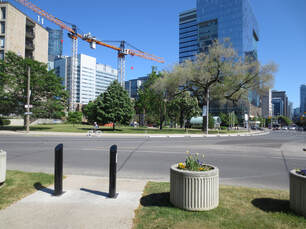|
|
Find the locations of items on our interactive map, which includes photos of the green space.
Green spaces = green squares Public art installations = yellow stars Points of Interest = red question marks Green spaces that are adjacent to the Bay Cloverhill area, and included on the Green Loop walking tour are identified with *. |
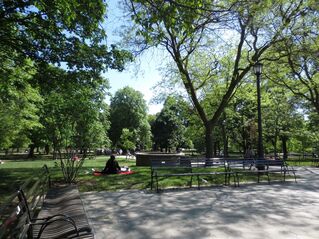
Queen's Park North, 110 Wellesley Street West
Originally a farm, Queen's Park was opened as the first Canadian municipal park in 1860, named after Queen Victoria. The area was heavily forested, and when it was cleared for the park, a sawmill was built at 67 St. Nicholas Street to process the cut down tree. The sawmill workers lived in the ten adjacent cottages that were named after plants and native tree species (Oak, Ivy, Rose, Spruce, Beech, Birch, Maple, Ash, Elm and Hazel). In attendance at the opening was her son, an eighteen year Prince of Wales, who would later be known as King Edward VII. The area north of Wellesley Street is called "Queen's Park North", with the area south of that, including the Ontario Legislature Building, known as "Queen's Park".
There are numerous entry points and pathways to the 49 acre site, as well as benches to enjoy a restful moment. Restoration work was completed in 2019 that included upgrading the jogging path that encircles the park, adding benches and pathways. Future improvements include direct access to the Museum TTC subway station and a bench made from a 200 year old white oak tree.
"Trees for Toronto" is a City of Toronto and Royal Ontario Museum program that planted native trees in the park and the various species are identified with small signs. Notable monuments and statues include the 48th Highlanders, Al Purdy and King Edward VII. A fountain is located at the south end of the park, but it is currently not operational.
Originally a farm, Queen's Park was opened as the first Canadian municipal park in 1860, named after Queen Victoria. The area was heavily forested, and when it was cleared for the park, a sawmill was built at 67 St. Nicholas Street to process the cut down tree. The sawmill workers lived in the ten adjacent cottages that were named after plants and native tree species (Oak, Ivy, Rose, Spruce, Beech, Birch, Maple, Ash, Elm and Hazel). In attendance at the opening was her son, an eighteen year Prince of Wales, who would later be known as King Edward VII. The area north of Wellesley Street is called "Queen's Park North", with the area south of that, including the Ontario Legislature Building, known as "Queen's Park".
There are numerous entry points and pathways to the 49 acre site, as well as benches to enjoy a restful moment. Restoration work was completed in 2019 that included upgrading the jogging path that encircles the park, adding benches and pathways. Future improvements include direct access to the Museum TTC subway station and a bench made from a 200 year old white oak tree.
"Trees for Toronto" is a City of Toronto and Royal Ontario Museum program that planted native trees in the park and the various species are identified with small signs. Notable monuments and statues include the 48th Highlanders, Al Purdy and King Edward VII. A fountain is located at the south end of the park, but it is currently not operational.
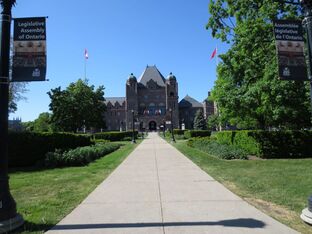
Queen's Park, 100 Wellesley Street West
The area south of Wellesley and north of College, bounded by Queen's Park Crescent, is known as "Queen's Park". The unique shape of Queen's Park is formed by Queen's Park Crescent, which mirrors the path of Taddle Creek. The Ontario Legislature Building contains the Legislative Assembly of Ontario (provincial government), offices of the Lieutenant Governor of Ontario, as well as Members of Provincial Parliament. The Romanesque Revival styled building was constructed with pink hued sandstone from the Credit River and Orangeville areas.
The Ontario Legislative Building anchors a large public space with numerous monuments, statutes and trees. In front of the building sits a pair of Russian cannons, gifted by Queen Victoria in 1859 after being captured during the Crimean War. West of the building entrance resides a statue of Sir Oliver Mowat, and on the east side the Queen Victoria statue serenely surveys the park, with a statue of John Sandfield Macdonald behind her. On the west side of the the building are rose gardens and plaques honouring Queen Elizabeth's Silver and Golden Jubilee, along with a plaque commemorating the 1939 Royal Tour. The east side of the building houses the Post One survey monument and statue of John Graves Simcoe. The centre of the park is occupied by a statue of George Brown, Sir James Pliny Whitney and Sir John A. Macdonald. It is also home to the Ontario Veteran's Memorial, the Northwest Rebellion Monument, various plaques and two gardens containing trilliums and Ontario native species plants.
The Legislative Assembly of Ontario offers a variety of interior and exterior tours for the building and grounds. For more details click Tour Information.
The area south of Wellesley and north of College, bounded by Queen's Park Crescent, is known as "Queen's Park". The unique shape of Queen's Park is formed by Queen's Park Crescent, which mirrors the path of Taddle Creek. The Ontario Legislature Building contains the Legislative Assembly of Ontario (provincial government), offices of the Lieutenant Governor of Ontario, as well as Members of Provincial Parliament. The Romanesque Revival styled building was constructed with pink hued sandstone from the Credit River and Orangeville areas.
The Ontario Legislative Building anchors a large public space with numerous monuments, statutes and trees. In front of the building sits a pair of Russian cannons, gifted by Queen Victoria in 1859 after being captured during the Crimean War. West of the building entrance resides a statue of Sir Oliver Mowat, and on the east side the Queen Victoria statue serenely surveys the park, with a statue of John Sandfield Macdonald behind her. On the west side of the the building are rose gardens and plaques honouring Queen Elizabeth's Silver and Golden Jubilee, along with a plaque commemorating the 1939 Royal Tour. The east side of the building houses the Post One survey monument and statue of John Graves Simcoe. The centre of the park is occupied by a statue of George Brown, Sir James Pliny Whitney and Sir John A. Macdonald. It is also home to the Ontario Veteran's Memorial, the Northwest Rebellion Monument, various plaques and two gardens containing trilliums and Ontario native species plants.
The Legislative Assembly of Ontario offers a variety of interior and exterior tours for the building and grounds. For more details click Tour Information.
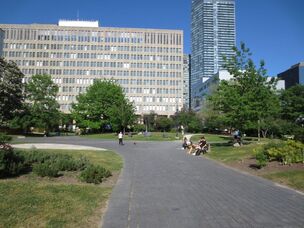
Whitney Plaza, 23 Queen's Park Crescent East
Adjacent to the Whitney Block of provincial government buildings, this quiet plaza has wide walkways, benches, and memorials dedicated to both Ontario Police and Ontario Correctional Workers.
Adjacent to the Whitney Block of provincial government buildings, this quiet plaza has wide walkways, benches, and memorials dedicated to both Ontario Police and Ontario Correctional Workers.
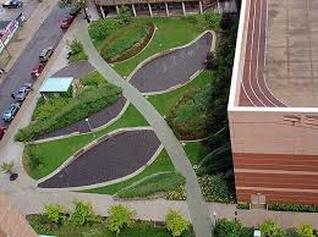
- Opera Place Park/Leaf Garden, 25 Breadalbane Street
-
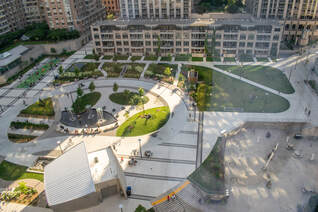
*College Park, 420 Yonge Street
After undergoing a major renovation, this park reopened in 2019. Designed to have something for everyone, there are green spaces, a children’s play area, reflecting pool and the seasonal Barbara Ann Scott Ice Trail.
After undergoing a major renovation, this park reopened in 2019. Designed to have something for everyone, there are green spaces, a children’s play area, reflecting pool and the seasonal Barbara Ann Scott Ice Trail.
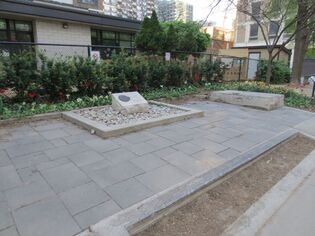
- St. Mary Street Parkette, 26 St. Mary Street
-

Clover Hill Park, 50 St. Joseph Street
In November 2020, Clover Hill Park was welcomed by the community as a much needed green space. The cost of the park improvements for the City of Toronto came from Section 37 development funds. The park features seating areas, green spaces, bike racks, water bottle filling station and a children’s playground with a water splash pad. A memorial bench celebrating Dr. Christine Buske by the Primrose sculpture provides a place to rest and reflect on the extraordinary University of Toronto student, educator and researcher who passed away in 2019.
In November 2020, Clover Hill Park was welcomed by the community as a much needed green space. The cost of the park improvements for the City of Toronto came from Section 37 development funds. The park features seating areas, green spaces, bike racks, water bottle filling station and a children’s playground with a water splash pad. A memorial bench celebrating Dr. Christine Buske by the Primrose sculpture provides a place to rest and reflect on the extraordinary University of Toronto student, educator and researcher who passed away in 2019.
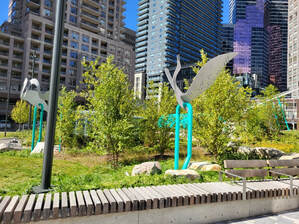
Dr. Lillian McGregor Park, 25 Wellesley Street West
The 1.6 acre L shaped park is named for Dr. Lillian McGregor of the Whitefish River First Nation who was recognized for her contributions in education and honouring indigenous culture. The planned artwork of crane figures, reed screens, feather canopy and a medicine wheel are inspired by Dr. McGregor’s family clan sign.
The park was open to the public in September 2022. There are spaces for relaxing, gathering, and a children’s playground. The official opening ceremony was held on May 9, 2023, with members of the McGregor family in attendance. Click on the files below to learn about the history behind the park.
The 1.6 acre L shaped park is named for Dr. Lillian McGregor of the Whitefish River First Nation who was recognized for her contributions in education and honouring indigenous culture. The planned artwork of crane figures, reed screens, feather canopy and a medicine wheel are inspired by Dr. McGregor’s family clan sign.
The park was open to the public in September 2022. There are spaces for relaxing, gathering, and a children’s playground. The official opening ceremony was held on May 9, 2023, with members of the McGregor family in attendance. Click on the files below to learn about the history behind the park.
|
| ||||||||||||
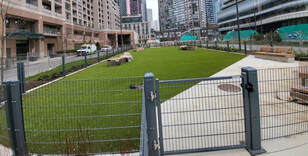
Breadalbane Park, 30 Breadalbane Street
The neighbourhood's only off leash dog park opened May 9, 2023 to the delight of canine residents. The space is open from 5:30 am to midnight daily. It is located adjacent to Dr. Lillian McGregor Park.
The neighbourhood's only off leash dog park opened May 9, 2023 to the delight of canine residents. The space is open from 5:30 am to midnight daily. It is located adjacent to Dr. Lillian McGregor Park.

